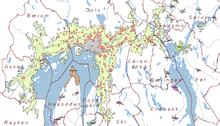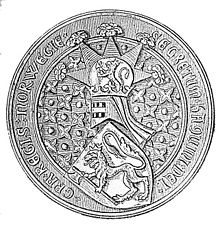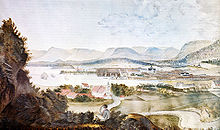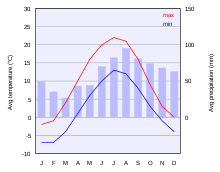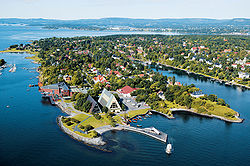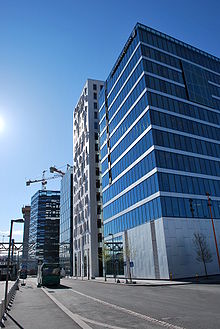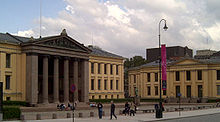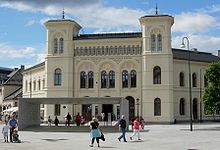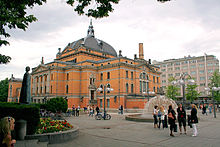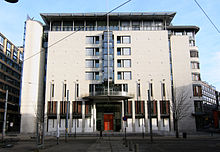- Oslo
-
This article is about the capital of Norway. For other uses, see Oslo (disambiguation).
Oslo Top: Parliament of Norway Building, middle left: Bjørvika, middle right: Oslo City Hall seen from Akershus Castle, bottom: Oslo Opera House 
Coat of armsMotto: Unanimiter et constanter
(Latin: United and constant)Coordinates: 59°56′58″N 10°45′23″E / 59.94944°N 10.75639°ECoordinates: 59°56′58″N 10°45′23″E / 59.94944°N 10.75639°E Country Norway District Østlandet County Oslo Municipality Oslo Established 1048 Government – Mayor Fabian Stang (H) – Governing mayor Stian Berger Røsland (H) Area – City 454.03 km2 (175.3 sq mi) – Urban 285.26 km2 (110.1 sq mi) – Metro 8,900 km2 (3,436.3 sq mi) Population (Oct. 2011) – City 611,491 – Density 1,346.8/km2 (3,488.2/sq mi) – Urban 912,046 – Urban density 3,197.2/km2 (8,280.8/sq mi) – Metro 1,442,318 – Metro density 162.1/km2 (419.7/sq mi) Ethnic groups[1] – Norwegians 71.5% – Pakistanis 3.6% – Somalis 2.0% – Swedes 2.0% – Poles 1.7% Time zone CET (UTC+1) – Summer (DST) CEST (UTC+2) Website oslo.kommune.no Oslo (English pronunciation: /ˈɒzloʊ/, oz-loh,[2] Norwegian pronunciation: [ˈʊʃlʊ] (
 listen) or [ˈʊslʊ]) is a municipality, as well as the capital and most populous city in Norway. As a municipality (formannskapsdistrikt), it was established on 1 January 1838. Founded around 1048 by King Harald III of Norway, the city was largely destroyed by fire in 1624. The city was moved under the reign of Denmark–Norway's King Christian IV. It was rebuilt closer to Akershus Castle, as Christiania (also spelled Kristiania in late 1800s). In 1925, the city reclaimed its original Norwegian name, Oslo. The diocese of Oslo is one of the five original dioceses in Norway, which originated around the year 1070.
listen) or [ˈʊslʊ]) is a municipality, as well as the capital and most populous city in Norway. As a municipality (formannskapsdistrikt), it was established on 1 January 1838. Founded around 1048 by King Harald III of Norway, the city was largely destroyed by fire in 1624. The city was moved under the reign of Denmark–Norway's King Christian IV. It was rebuilt closer to Akershus Castle, as Christiania (also spelled Kristiania in late 1800s). In 1925, the city reclaimed its original Norwegian name, Oslo. The diocese of Oslo is one of the five original dioceses in Norway, which originated around the year 1070.Oslo is the cultural, scientific, economic and governmental centre of Norway. The city is also a hub of Norwegian trade, banking, industry and shipping. It is an important centre for maritime industries and maritime trade in Europe. The city is home to many companies within the maritime sector, some of which are amongst the world's largest shipping companies, shipbrokers and maritime insurance brokers. Oslo is a pilot city of the Council of Europe and the European Commission intercultural cities programme.
Oslo is considered a global city and ranked "Beta World City" in studies performed by the Globalization and World Cities Study Group and Network in 2008.[3] For several years, Oslo has been listed as one of the most expensive cities in the world along with such other global cities, as Zurich, Geneva, Copenhagen, Paris, and Tokyo.[4] In 2009, however, Oslo regained its status as the world's most expensive city.[5][6] A survey conducted by ECA International in 2011 placed Oslo 2nd after Tokyo.[7]
As of 2010, the metropolitan area of Oslo has a population of 1,442,318 of whom 912,046[8] live in the contiguous conurbation. The population currently increases at a record rate of 1.64% annually, making it the fastest growing city in Europe.[9] This growth stems from immigration, as the Norwegian population in the city is decreasing.[10] The immigrant share of the population in the city proper now counts more than 25% of the city's total.[11]
Urban region
The population of the municipality of Oslo is 611,491 as of 1 Oct. 2011.[12][13] The urban area extends beyond the boundaries of the municipality into the surrounding county of Akershus, (municipalities of Bærum, Asker, Røyken, Lørenskog, Skedsmo, Gjerdrum, Sørum, Oppegård) its agglomeration total 912,046 inhabitants.[14] The metropolitan area of Oslo, also referred to as the Greater Oslo Region (Norwegian: Stor-Osloregionen), has a land area of 8,900 km2 (3,400 sq mi)[15] with a population of 1,422,442 as of 1 Apr. 2010. The Inner Oslo Fjord Region, or the Capital Region made up by the 5 counties of Oslo, Akershus, Buskerud, Vestfold (west bank of the Oslo fjord) and Østfold (east bank) has a population of 1,908,231 people (01.10.2010). The city centre is situated at the end of the Oslofjord, from which point the city sprawls out in three distinct "corridors" from its centre; inland north-eastwards and southwards along both sides of the fjord giving the city area more or less the shape of a reclining "Y" when seen from the north. To the north and east, wide forested hills (Marka) rise above the city giving the location the shape of a giant amphitheatre. The urban municipality (bykommune) of Oslo and county of Oslo (fylke) are two parts of the same entity, making Oslo the only city in Norway where two administrative levels are integrated. Of Oslo's total area, 115 km2 (44 sq mi) is built-up and 7 km2 (2.7 sq mi) is agricultural. The open areas within the built-up zone amount to 22 km2 (8.5 sq mi).
The city of Oslo was established as a municipality on 3 January 1838 (see formannskapsdistrikt). It was separated from the county of Akershus to become a county of its own in 1842. The rural municipality of Aker was merged with Oslo on 1 January 1948 (and simultaneously transferred from Akershus county to Oslo county). Furthermore, Oslo shares several important functions with Akershus county. The neighbouring industrial commune of Aker was incorporated into Oslo in 1948.
General information
Toponymy
For full article, see History of Oslo's nameThe origin of the name Oslo has been the subject of much debate. While certainly derived from Old Norse, it was in all probability originally the name of a large farm at the site of the first settlements in Bjørvika.
Most modern linguists lean toward an interpretation of "Oslo/Åslo" as either "the meadow at the foot of the hill", with the name serving a topographical description, or the possibility of the name referring to an ancient site of worship in "the meadow consecrated to the gods". Both interpretations are considered equally likely.
Erroneously, it was once assumed that Oslo meant "the mouth of the Lo river", referring to another name of the river Alna. This apocryphal story is not only ungrammatical (the correct form would be Loaros, cf. Nidaros), but the name Lo is not recorded anywhere before Peder Claussøn Friis first used it in the same work in which he proposed this etymology.[16] The name Lo is now believed to be a back-formation arrived at by Friis in support of his spurious etymology for Oslo.[17]
City seal
Main article: Seal of OsloOslo is one of very few cities in Norway, besides Bergen and Tønsberg, that does not have a formal coat-of-arms, but which uses a city seal instead.[18] The seal of Oslo shows the city's patron saint, St. Hallvard, with his attributes, the millstone and arrows, with a naked woman at his feet. He is seated on a throne with lion decorations, which at the time was also commonly used by the Norwegian Kings.[19]
History
Oslo Timeline (major events) CA. 1000 AD First traces of buildings. The Clemens church is built. CA. 1050 AD Oslo marked as a city. Mariakirken is built. 1152/53 AD The Cathedral school is established 1299 AD Oslo becomes the capital of Norway CA. 1300 Construction of Akershus Fortress starts. 1350 AD Around 3/4 of the population dies under the Black Death. 1352 AD Hallvards Cathedral and the other Sogne Churches are burned to the ground in a major fire 1624 AD Another major fire, the city is rebuilt and renamed Christiania by Christian 4. 1686 AD Fire ruins 1/4 of the city. 1697 AD Domkirken is finished and opened 1716 AD The city and the fortress conquered by Karl 12. 1813 The University is opened. 1825 The foundations of Slottet are finished. 1836 The National Gallery is finished. 1837 Christiania Theatre is opened. Christiania and Aker get a Mayor and kommunestyre. 1854 Oslo gets its first railway, which leads to Eidsvoll. 1866 Stortinget is completed. 1878 City expanded. Frogner, Majorstuen, Torshov, Kampen and Vålerengen are populated and rebuilt. 113000 citizens. 1892 The first Holmenkollbakken is finished. 1894 The city gets its first electrical track. 1899 Nationaltheateret is finished. 1925 City renamed as Oslo. 1927 The Monolith is raised. 1928 Oslo first Metro line, Majorstuen-Besserud is opened. 1950 Oslo City Hall opened. 1963 The Munch Museum is opened. 1980 Metro line under the city, Oslo Central Station and Nationaltheatret Station opened. 1997 Population over 500 000. 1998 Rikshospitalet opened. New railway line to Gardermoen. 2000 The city celebrates thousand-years jubilee. 2008 Oslo Opera House is opened. 2011 Several buildings in the Regjeringskvartalet are heavily damaged during a terrorist attack, resulting in 8 deaths. 69 people are massacred on the nearby Utøya island. According to the Norse sagas, Oslo was founded around 1049 by King Harald Hardråde.[20] Recent archaeological research has uncovered Christian burials which can be dated to prior to 1000 CE, evidence of a preceding urban settlement. This called for the celebration of Oslo's millennium in 2000.
It has been regarded as the capital city since the reign of King Håkon V (1299–1319), the first king to reside permanently in the city. He also started the construction of the Akershus Castle. A century later, Norway was the weaker part in a personal union with Denmark, and Oslo's role was reduced to that of provincial administrative centre, with the monarchs residing in Copenhagen. The fact that the University of Oslo was founded as late as 1811 had an adverse effect on the development of the nation.
Oslo was destroyed several times by fire, and after the fourteenth calamity, in 1624, King Christian IV of Denmark and Norway ordered it rebuilt at a new site across the bay, near Akershus Castle and given the name Christiania. Long before this, Christiania had started to establish its stature as a centre of commerce and culture in Norway. The part of the city built starting in 1624 is now often called Kvadraturen because of its orthogonal layout. The last plague outbreak ravaged Oslo in 1654.[21] In 1814 Christiania once more became a real capital when the union with Denmark was dissolved.
Many landmarks were built in the 19th century, including the Royal Palace (1825–1848); Stortinget (the Parliament) (1861–1866), the University, Nationaltheatret and the Stock Exchange. Among the world-famous artists who lived here during this period were Henrik Ibsen and Knut Hamsun (the latter was awarded the Nobel Prize for literature). In 1850, Christiania also overtook Bergen and became the most populous city in the country. In 1877 the city was renamed Kristiania. The original name of Oslo was restored in 1925.
1000–1700
Under the reign of King Olav Kyrre, Oslo became a cultural centre for Eastern Norway. St. Hallvard became the city's patron saint and is depicted on the city's seal.
In 1174, Hovedøya Abbey (Hovedøya kloster) was built. The churches and abbeys became major owners of large tracts of land, which proved important for the city's economic development, especially before the Black Death.
During the Middle Ages, Oslo reached its heights in the reign of King Håkon V. He started the building of Akershus Castle and was also the first king to reside permanently in the city, which helped to make Oslo the capital of Norway.
In the end of the 12th century, Hanseatic traders from Rostock moved into the city and gained major influence in the city. The Black Death came to Norway in 1349 and, like other cities in Europe, the city suffered greatly. The churches' earnings from their land also dropped so much that the Hanseatic traders dominated the city's foreign trade in the 15th century.
Over the years, fire destroyed major parts of the city many times, as many of the city's buildings were built entirely of wood. After the last fire in 1624, which lasted for three days, King Christian IV decided that the old city should not be rebuilt again. His men built a network of roads in Akershagen near Akershus Castle. He demanded that all citizens should move their shops and workplaces to the newly built city of Christiania.
The transformation of the city went slowly for the first hundred years. Outside the city, near Vaterland and Grønland near Gamle Oslo a new, unmanaged part of the city grew up with citizens of low status.
1700s
In the 18th century, after the Great Northern War, the city's economy boomed with shipbuilding and trade. The strong economy transformed Christiania into a trading port.
1800s
In the 19th century, several state institutions were established and the city's role as a capital intensified. Christiania expanded its industry from 1840, most importantly around Akerselva. The expansion prompted the authorities to construct several important buildings, most of which remain as tourist attractions. There was a brief building boom from 1880, with many new houses, but the boom collapsed in 1889.
1900–present
Auctioning off of children was prohibited by law (Fattigloven) in 1900, as a result of court cases related to children having died/been killed.[22]
The kommune developed new areas such as Ullevål Hageby (1918–1926) and Torshov (1917–1925). City Hall was constructed in the former slum area of Vika, from 1931–1950. The municipality of Aker was incorporated into Oslo in 1948, and suburbs were developed, such as Lambertseter (from 1951). Aker Brygge was constructed on the site of the former shipyard Akers Mekaniske Verksted, from 1982–1998.
On 22 July 2011, Oslo was hit by a bomb blast that ripped through the city central government district, also damaging Prime Minister Jens Stoltenberg's office while he was absent and the nearby Ministry of Petroleum. The terrorist blast killed at least eight people prior to a shooting spree on the island of Utøya on lake Tyrifjorden, which killed 69 youths participating in a Norwegian Labour Party youth camp. The suspect is Anders Behring Breivik.
Geography
See also: Oslo GrabenOslo occupies an arc of land at the northernmost end of the Oslofjord. The fjord, which is nearly bisected by the Nesodden peninsula opposite Oslo, lies to the south; in all other directions Oslo is surrounded by green hills and mountains. There are 40 islands within the city limits, the largest being Malmøya (0.56 km2/0.22 sq mi), and scores more around the Oslofjord. Oslo has 343 lakes, the largest being Maridalsvannet (3.91 km2/1.51 sq mi). This is also a main source of drinking water for large parts of Oslo.
Although Eastern Norway has a number of rivers, none of these flow into the ocean at Oslo. Instead Oslo has two smaller rivers: Akerselva (draining Maridalsvannet, which flows into the fjord in Bjørvika), and Alna. The waterfalls in Akerselva gave power to the first modern industry of Norway in the 1840, and later in the century, the river became the symbol of the stable and consistent economic and social divide of the city into an East End and a West End; the labourers' neighbourhoods lie on both sides of the river, and the divide in reality follows Uelands street a bit further west. River Alna flows through Groruddalen, Oslo's major suburb and industrial area. The highest point is Kirkeberget, at 629 metres (2,064 ft). Although the city's population is small compared to most European capitals, it occupies an unusually large land area, of which two thirds are protected areas of forests, hills and lakes. Its boundaries encompass many parks and open areas, giving it an airy and green appearance.
Climate
Oslo has a humid continental climate (Dfb according to the Köppen climate classification system). Because of the city's northern latitude, daylight varies greatly, from more than 18 hours in midsummer, when it never gets completely dark at night, to around 6 hours in midwinter.[citation needed] Despite its northerly location, the climate is relatively mild throughout the year because of the Gulf Stream.
Oslo has pleasantly mild to warm summers with average high temperatures of 20–22 °C (68–72 °F) and lows of around 12 °C (54 °F). Temperatures exceed 25 °C (77 °F) quite often, and heatwaves are common during the summer. The highest temperature ever recorded was 35 °C (95 °F) on 21 July 1901. Due to the fjord being a relatively enclosed body of water, the water temperatures can get quite high during long warm periods. Winters are cold and snowy with temperatures between −7 °C (19 °F) up to −1 °C (30 °F). The coldest temperature recorded is −27.1 °C (−16.8 °F) in January 1942.[23] Temperatures have tended to be higher in recent years.[24]
Annual precipitation is 763 millimetres (30.0 in) with moderate rainfall throughout the year. Snowfall can occur from November to April, but snow accumulation occurs mainly from January through March. Almost every winter, ice develops in the innermost parts of the Oslofjord, and during some winters the whole inner fjord freezes. As it is far from the mild Atlantic water of the west coast, this large fjord can freeze over completely, although this has become rare.[25] Even for its latitude, Oslo is outstandingly cloudy, receiving a diminutive average of 1,668 hours of bright sunshine annually.
Climate data for Oslo, Norway Month Jan Feb Mar Apr May Jun Jul Aug Sep Oct Nov Dec Year Record high °C (°F) 13
(55)15
(59)18
(64)26
(79)30
(86)34
(93)35
(95)34
(94)27
(81)23
(74)14
(58)13
(55)35
(95)Average high °C (°F) −1.8
(28.8)−0.9
(30.4)3.5
(38.3)9.1
(48.4)15.8
(60.4)20.4
(68.7)21.5
(70.7)20.1
(68.2)15.1
(59.2)9.3
(48.7)3.2
(37.8)−0.5
(31.1){{{year high C}}}
(49.2)Daily mean °C (°F) −4.3
(24.3)−3.9
(25.0)0.1
(32.2)5.0
(41.0)10.1
(50.2)15.5
(59.9)16.9
(62.4)15.7
(60.3)11.3
(52.3)6.6
(43.9)0.9
(33.6)−3.1
(26.4)5.9 Average low °C (°F) −6.8
(19.8)−6.8
(19.8)−3.3
(26.1)0.8
(33.4)6.5
(43.7)10.6
(51.1)12.2
(54.0)11.3
(52.3)7.5
(45.5)3.8
(38.8)−1.5
(29.3)−5.6
(21.9){{{year low C}}}
(36.3)Record low °C (°F) −26
(−15)−25
(−13)−21
(−6)−16
(3)−4
(24)1
(33)4
(39)2
(36)−4
(25)−11
(12)−16
(3)−24
(−11)−26
(−15)Precipitation mm (inches) 49
(1.93)36
(1.42)47
(1.85)41
(1.61)53
(2.09)65
(2.56)81
(3.19)89
(3.5)90
(3.54)84
(3.31)73
(2.87)55
(2.17)763
(30.04)Snowfall cm (inches) 14.1
(5.55)21.8
(8.58)21.4
(8.43)3.5
(1.38)0
(0)0
(0)0
(0)0
(0)0
(0)0.4
(0.16)4.3
(1.69)11.7
(4.61)77.2
(30.39)Avg. rainy days 3 3 7 11 10 13 15 14 14 14 5 3 112 Avg. snowy days 12 9 3 1 0 0 0 0 0 1 12 15 53 Sunshine hours 40 76 126 178 220 250 246 216 144 86 51 35 1,668 Source no. 1: Minifakta om Norge (SSB)[26] Source no. 2: The Weather Network [27] Parks and recreation areas
Main article: Parks and open spaces in OsloOslo has a large number of parks and green areas within the city core, as well as outside it.
- Frogner Park is a large park located a few minutes walk away from the city centre. This is the biggest and most reputed park in Norway with a large collection of sculptures of Gustav Vigeland
- Bygdøy is a huge and green area, commonly called the Museum Peninsula of Oslo. The beautiful location, surrounded by the sea, makes it the most expensive Norwegian district.
- St. Hanshaugen Park is an old public park on a high hill in central Oslo. 'St. Hanshaugen' is also the name of the surrounding neighbourhood as well as the larger administrative district (borough) that includes major parts of central Oslo.[28]
- Tøyen Park stretches out behind the Munch Museum, and is a vast, grassy expanse. In the north, there is a viewing point known as Ola Narr. The Tøyen area also includes the Botanical Garden and Museum belonging to the University of Oslo.[29]
Oslo (with neighbouring Sandvika-Asker) is built in a horseshoe shape on the shores of the Oslofjord and limited in most directions by hills and forests. As a result, any point within the city is relatively close to the forest. There are two major forests bordering the city: Østmarka (literally "Eastern Forest", on the eastern perimeter of the city), and the very large Nordmarka (literally "Northern Forest", stretching from the northern perimeter of the city deep into the hinterland).
The municipality operates eight public swimming pools.[30] Tøyenbadet is the largest indoor swimming facility in Oslo and one of the few pools in Norway offering a 50-metre main pool. The outdoor pool Frognerbadet also has the 50-metre range.
Cityscape
Oslo's cityscape is being redeveloped as a modern city with various access-points, an extensive metro-system with a new financial district and a cultural city. In 2008, an exhibition was held in London presenting the award-winning Oslo Opera House, the urban regeneration scheme of Oslo's seafront, Munch/Stenersen and the new Deichman Library. Most of the buildings in the city and in neighbouring communities are low in height with only the Plaza, Postgirobygget and the highrises at Bjørvika considerably taller.
Architecture
Oslo's architecture is very diverse. Architect Carl Frederik Stanley (1769–1805), who was educated in Copenhagen, spent some years in Norway around the turn of the 19th century. He did minor works for wealthy patrons in and around Oslo, but his major achievement was the renovation of the Oslo Katedralskole, completed in 1800.[citation needed] He added a classical portico to the front of an older structure, and a semi-circular auditorium that was sequestered by Parliament in 1814 as a temporary place to assemble, now preserved at Norsk Folkemuseum as a national monument.
Christiania, in 1814 promoted to the status of a capital city, had practically no buildings suitable for the many new government institutions. An ambitious building program was initiated, but realised very slowly because of a strained economy. The first major undertaking was the Royal Palace, designed by Hans Linstow and built between 1824 and 1848. Linstow also planned Karl Johans gate, the avenue connecting the Palace and the city, with a monumental square halfway to be surrounded by buildings for the University, the Parliament (Storting) and other institutions. Only the University buildings were realised according to this plan. Christian Heinrich Grosch, one of the first fully educated architects in Norway, designed the original building for the Oslo Stock Exchange (1826–1828), the local branch of the Bank of Norway (1828), Christiania Theatre (1836–1837), and the first campus for the University of Oslo (1841–1856). For the University buildings, he sought the assistance of the renowned German architect Karl Friedrich Schinkel.
The German architectural influence persisted in Norway, and many wooden buildings followed the principles of Neoclassicism. In Oslo, the German architect Alexis de Chateauneuf designed Trefoldighetskirken, the first neo-gothic church, completed by von Hanno in 1858.
A number of landmark structures, particularly in Oslo, were built in the functionalist style, the first one being the Skansen restaurant (1925–1927) by Lars Backer, demolished in 1970. Backer also designed the restaurant at Ekeberg, opened in 1929. The art gallery Kunstnernes Hus by Gudolf Blakstad and Herman Munthe-Kaas (1930) still shows influence from the preceding classicist trend of the 1920s. Oslo Airport (by the Aviaplan consortium at Gardermoen was Norway's largest construction project ever.
Politics and government
Main article: Politics and government of Oslo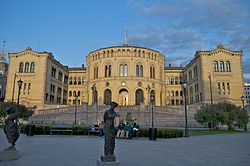 Stortinget is the seat of Norway's parliament.
Stortinget is the seat of Norway's parliament.
Oslo is the capital of Norway, and as such is the seat of Norway's national government. Most government offices, including that of the Prime Minister, are gathered at Regjeringskvartalet, a cluster of buildings close to the national Parliament—the Storting.
Constituting both a municipality and a county of Norway, the city of Oslo is represented in the Storting by seventeen Members of Parliament. Six MPs are from the Labour Party; the Conservative Party and the Progress Party have three each; the Socialist Left Party and the Liberals have two each; and one is from the Christian Democrats.
The combined municipality and county of Oslo has had a parliamentary system of government since 1986. The supreme authority of the city is the City Council (Bystyret), which currently has 59 seats. Representatives are popularly elected every four years. The City Council has five standing committees, each having its own areas of responsibility. The largest parties in the City Council after the 2011-elections are the Conservatives and the Labour Party, with 22 and 20 representatives respectively.
The Mayor of Oslo is the head of the City Council and the highest ranking representative of the city. This used to be the most powerful political position in Oslo, but following the implementation of parliamentarism, the Mayor has had more of a ceremonial role, similar to that of the President of the Storting at the national level. The current Mayor of Oslo is Fabian Stang.
Since the local elections of 2003, the city government has been a coalition of the Conservative Party and the Progress Party. Based mostly on support from the Christian Democrats and the Liberals, the coalition maintains a workable majority in the City Council. After the 2007 local elections on 10 September, the conservative coalition remained in majority. After the elections in 2011 the Conservative Party remained in power after a strong election. The Progress Party chose to leave the city government after loosing support in the election and a dispute over the new Munch Museum. The Liberals and the Christian Democrats replaced the Progress Party in the city government.
The Governing Mayor of Oslo is the head of the City government. The post was created with the implementation of parliamentarism in Oslo and is similar to the role of the prime minister at the national level. The current governing mayor is Stian Berger Røsland.
Economy
Main article: Economy of Greater OsloOffice buildings in Bjørvika, part of the redesign of former dock and industrial land in Oslo known as The Barcode Project.
Oslo is an important centre of maritime knowledge in Europe and is home to approximately 1980 companies and 8,500 employees within the maritime sector, some of which are the world's largest shipping companies, shipbrokers, and insurance brokers.[31] Det Norske Veritas, headquartered at Høvik outside Oslo, is one of the three major maritime classification societies in the world, with 16.5% of the world fleet to class in its register.[32] The city's port is the largest general cargo port in the country and its leading passenger gateway. Close to 6,000 ships dock at the Port of Oslo annually with a total of 6 million tonnes of cargo and over five million passengers. The gross domestic product of Oslo totalled NOK268.047 billion (€33.876 billion) in 2003, which amounted to 17% of the national GDP.[33] This compares with NOK165.915 billion (€20.968 billion) in 1995. The metropolitan area, bar Moss and Drammen, contributed 25% of the national GDP in 2003 and was also responsible for more than one quarter of tax revenues. In comparison, total tax revenues from the oil and gas industry on the Norwegian Continental Shelf amounted to about 16%.[34]
Oslo is one of the most expensive cities in the world.[35] As of 2006, it is ranked tenth according to the Worldwide Cost of Living Survey provided by Mercer Human Resource Consulting[36] and first according to the Economist Intelligence Unit.[37] The reason for this discrepancy is that the EIU omits certain factors from its final index calculation, most notably housing. Although Oslo does have the most expensive housing market in Norway, it is comparably cheaper than other cities on the list in that regard. Meanwhile, prices on goods and services remain some of the highest of any city. Oslo hosts 2654 of the largest companies in Norway. Within the ranking of Europe's largest cities ordered by their number of companies Oslo is in fifth position. A whole group of oil and gas companies is situated in Oslo. According to a report compiled by Swiss bank UBS in the month of August 2006,[38] Oslo and London were the world's most expensive cities.
Environment
Oslo is a compact city. It is easy to move around by public transportation and you can access rentable city bikes all over the city centre. In 2003, Oslo received The European Sustainable City Award and in 2007 Reader's Digest ranked Oslo as number two on a list of the world's greenest, most liveable cities.[39][40]
See also Transportation
Education
Institutions of higher education
- University of Oslo (Universitetet i Oslo) – undergraduate, graduate and PhD programs in most fields.
- Oslo University College (Høgskolen i Oslo) – focuses on 3–4 year professional degree programs.
- BI Norwegian Business School (Handelshøyskolen BI) – primarily economics and business administration.
- Norwegian School of Information Technology (Norges Informasjonsteknologiske Høyskole)
- Oslo School of Architecture and Design (Arkitektur- og designhøgskolen i Oslo)
- Norwegian School of Sport Sciences (Norges idrettshøgskole) – offers opportunities to study at the Bachelor, Masters and Doctoral level[41]
- Norwegian Academy of Music (Norges musikkhøgskole)
- MF Norwegian School of Theology (Det teologiske Menighetsfakultet — MF)
- Oslo National Academy of the Arts (Kunsthøgskolen i Oslo KHIO)[42]
- Norwegian University of Life Sciences (Universitetet for Miljø og Biovitenskap-UMB) located right outside of Oslo[43]
- Norwegian Military Academy (Krigsskolen)
- Norwegian School of Veterinary Science (Norges Veterinærhøgskole)[44]
- Oslo Academy of Fine Arts (Statens kunstakademi)[45]
- Oslo School of Management (Markedshøyskolen)
The level of education and productivity in the workforce is high in Norway. Nearly half of those with education at tertiary level in Norway live in the Oslo region, placing it among Europe's top three regions in relation to education. In 2008, the total workforce in the greater Oslo region (5 counties) numbered 1,020,000 people. The greater Oslo region has several higher educational institutions and is home to more than 73,000 students. The University of Oslo is the largest educational institution with 27,700 students and 5,900 employees.
Culture
Oslo has a large and varied number of cultural attractions, which include several buildings containing artwork from Edvard Munch and various other international artists but also several Norwegian artists. Several world-famous writers have either lived or been born in Oslo. Examples are Knut Hamsun and Henrik Ibsen. The government has recently invested large amounts of money in cultural installations, facilities, buildings and festivals in the City of Oslo. Bygdøy, outside the city centre is the centre for history and the Norwegian Vikings' history. The area contains a large amount of parks and seasites and a large amount of museums. Examples are the Fram Museum, Vikingskiphuset and the Kon-Tiki Museum. Oslo hosts the annual Oslo Freedom Forum, a conference described by The Economist as “on its way to becoming a human-rights equivalent of the Davos economic forum.”[46] Oslo is also known for giving out the Nobel Peace Prize every year.
Museums, galleries
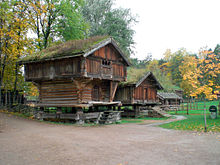 Historic buildings at Norsk Folkemuseum
Historic buildings at Norsk Folkemuseum
Oslo houses several major Museums and galleries. The Munch Museum contains the Scream and other work by Edvard Munch who donated all his work to the city after his death.[47] The City-Council is currently planning a new Munch Museum which is most likely to be built in Bjørvika, in the southeast of the city.[48] The museum will be named Munch/Stenersen.[48] 50 different museums are located around the city.[49] Folkemuseet is located on the Bygdøy peninsula and is dedicated to Folk art, Folk Dress, Sami culture and the viking culture. The outdoor museum contains 155 authentic old buildings from all parts of Norway, including a Stave Church.[50] The Vigeland Museum located in the large Vigeland Park by many people known as the Frognerpark is free to access and contains over 212 sculptures by Gustav Vigeland including an obelisk and the Wheel of Life.[51] Another popular sculpture is Sinnataggen, a baby boy stamping his foot in fury. This statue is very well known as an icon in the city.[52] Vikingskiphuset contains three vikingships found at Oseberg, Gokstad and Tune and several other unique items from the Viking age.[53] The Oslo City Museum holds a permanent exhibition about the people in Oslo and the history of the city.[54] The Kon-Tiki Museum houses Thor Heyerdahls Kontiki and Ra2.[55]
The National Museum holds and preserves, exhibits and promotes public knowledge about Norway's most extensive collection of art.[56] The Museum shows permanent exhibitions of works from its own collections but also temporary exhibitions that incorporate work loaned from elsewhere.[56] The National Museums exhibition avenues are the National Gallery, the Museum of Contemporary Art, the National Museum, the Museum of Decorative Arts and the National Museum of Architecture.[56] A new National Museum in Oslo will be built in the next 10 years. The winner was Forum Artis, and the building will be located at Vestbanen behind the Nobel Peace Center.[57] The Nobel Peace Center is an independent organisation opened on 11 June 2005 by the King Harald V as part of the celebrations to mark Norway's centenary as an independent country.[58] The building houses a permanent exhibition, expanding every year when a new Nobel Peace Prize winner is announced, containing information of every winner in history. The building is mainly used as a communication centre.[58]
Music and events
A large number of festivals are held in Oslo, such as Oslo Live, a rock and roll event, and the Oslo Jazz festival is a six-day festival which has been held annually in August for the past 25 years.[59] Oslo's biggest Rock festival is Øyafestivalen or simply "Øya". It draws about 60,000 people to the Medieval Park east in Oslo and last for four days.[60]
The Oslo World Music Festival showcases people who are stars in their own country but strangers in Norway. The Oslo Chamber Music Festival is held in August every year and world-class chambers and soloists gather in Oslo to perform at this festival. The Norwegian Wood Rock Festival is held every year in June in Oslo.
The Nobel Peace Prize Ceremony is headed by the Institute; the award ceremony is held annually in The City Hall on 10 December.[61] Even though Sami land is far away from the capital, the Norwegian Museum of Cultural History marks the Sami National Day with a series of activities and entertainment.
The World Cup Biathlon in Holmenkollen is held every year and here male and female competitors compete against each other in Sprint, Pursuit and Mass Start disciplines.[62]
Other examples of annual events in Oslo are Desucon, a convention focusing on Japanese culture[63] and Færderseilasen, the world's largest overnight regatta with more than 1100 boats taking part every year.[64]
Rikard Nordraak, composer of the Norwegian national anthem, was born in Oslo in 1842.
Norway's principal orchestra is the Oslo Philharmonic, based at the Oslo Concert Hall since 1977. Although it was founded in 1919, the Oslo Philharmonic can trace its roots to the founding of the Christiania Musikerforening (Christiania Musicians Society) by Edvard Grieg and Johan Svendsen in 1879.[65]
Performing arts
Oslo houses over 20 theatres, such as the Norwegian Theatre and the National Theatre located at Karl Johan Street. The National Theatre is the largest theatre in Norway and is situated between the castle and the Storting.[66] The names of Ludvig Holberg, Henrik Ibsen and Bjørnstjerne Bjørnson are engraved on the façade of the building over the main entrance. This theatre represents the actors and play-writers of the country but the songwriters, singers and dancers are represented in the form of a newly opened Oslo Opera House, situated in Bjørvika. The Opera was opened in 2008 and is a national landmark, designed by the Norwegian architectural firm, Snøhetta. There are two houses, together containing over 2000 seats. The building cost 500 million euro to build and took five years to build and is known for being the first Opera House in the world to let people walk on the roof of the building. The foyer and the roof are also used for concerts as well as the three stages.[67]
Literature
Most great Norwegian authors have lived in Oslo for some period in their life. For example Nobel Prize author Sigrid Undset grew up Oslo, and has described her life here in the autobiographical novel Elleve år (1934; translated as The longest years; New York 1971).
Playwright Henrik Ibsen is probably the most famous Norwegian author. Ibsen wrote plays such as Peer Gynt, A Doll's House and The Lady from the Sea. The Ibsen Quotes project completed in 2008 is a work of art consisting of 69 Ibsen quotations in stainless steel lettering which have been set into the granite sidewalks of the city's central streets.[68]
In recent years, novelists like Lars Saabye Christensen, Tove Nilsen and Roy Jacobsen have described the city and its people in their novels. Early 20th century literature from Oslo include poets Rudolf Nilsen and André Bjerke.
Media
The newspapers Aftenposten, Dagbladet, Verdens Gang, Dagens Næringsliv, Finansavisen, Dagsavisen, Morgenbladet, Vårt Land, Nationen and Klassekampen are published in Oslo. The main office of the national broadcasting company NRK is located at Marienlyst in Oslo, near Majorstuen. TVNorge (TVNorway) is also located in Oslo, while TV 2 (based in Bergen) and TV3 (based in London) operate branch offices in central Oslo. There is also a variety of specialty publications and smaller media companies. A number of magazines are produced in Oslo. The two dominant companies are Aller Media and Hjemmet Mortensen AB.
 Supporters cheering for their team in Bislett Stadion
Supporters cheering for their team in Bislett Stadion
Sports
Holmenkollen National Arena and Holmenkollbakken is the country's main biathlon and Nordic skiing venue. It hosts annual world cup tournaments, including the Holmenkollen Ski Festival. It has hosted Biathlon World Championships in 1986, 1990, 1999 and 2002. FIS Nordic World Ski Championships have been hosted in 1930, 1966, 1982 and 2011, as well as the 1952 Winter Olympics.
Ullevål Stadion is the home arena for the Tippeligaen football side Vålerenga Fotball, the Norwegian national football team and the Football Cup Final. The stadium has previously hosted the finals of the UEFA Women's Championship in 1987 and 1997, and the 2002 UEFA European Under-19 Football Championship.[69] Røa IL is Oslo's only team in the women's league, Toppserien. Each year, the international youth football tournament Norway Cup is held on Ekebergsletta and other places in the city.
Bislett Stadion is the city's main track and field venue, and hosts the annual Bislett Games, part of IAAF Diamond League. Bjerke Travbane is the main venue for harness racing in the country. Oslo Spektrum is used for large ice hockey and handball matches. Bækkelagets SK and Nordstrand IF plays in the women's Postenligaen in handball, while Vålerenga Håndball plays in the men's league. Jordal Amfi, the home of the ice hockey team Vålerenga Ishockey, and Manglerudhallen is the home of Manglerud Star, both of whom play in GET-ligaen. The 1999 IIHF World Championship in ice hockey were held in Oslo, as have three Bandy World Championships, in 1961, 1977 and 1985. The UCI Road World Championships in bicycle road racing were hosted 1993.
Crime
Oslo Police District is Norway's largest police district with over 2300 employees. Over 1700 of those are policemen, nearly 140 police lawyers and 500 civil employees. Oslo Police District has five police stations located around the city. Kripos is located in Oslo, which is a Norwegian special police division under the NMJP.
PST is also located in the Oslo District. PST is a security agency which was established in 1936 and is one of the non-secret agencies in Norway. At least two known underground NATO facilities are located in The Oslo District, one underground in Kolsås near NSM which is one of Norway's major national security authorities.
On 22 July 2011, Oslo was the site of one of two terrorist attacks: a bombing of Oslo government offices, and a shooting at a youth camp in Utøya.[70]
Transportation
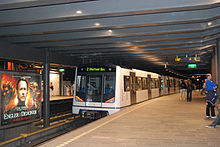 Train leaving Nationaltheatret (station)
Train leaving Nationaltheatret (station)
Oslo has Norway's most extensive public transport system, managed by Ruter.[71] This includes the six-line Oslo Metro,[72] the world's most extensive metro per resident, the six-line Oslo Tramway[73] and the eight-line Oslo Commuter Rail.[74] The tramway operates within the areas close to the city centre, while the metro, which runs underground through the city centre, operates to suburbs further away; this includes two lines which operate to Bærum, and the Ring Line which loops to areas north of the centre.[75]
Oslo Central Station acts as the central hub,[76] and offers train services to most major cities in southern Norway as well as Stockholm and Gothenburg in Sweden.[77] The Airport Express Train operates along the high-speed Gardermoen Line. The Drammen Line runs under the city centre in the Oslo Tunnel.[78] Some of the city islands and the neighbouring municipality of Nesodden are connected by ferry.[79] Daily cruiseferry services operate to Copenhagen and Frederikshavn in Denmark, and to Kiel in Germany.[80]
Many of the motorways pass through the downtown and other parts of the city in tunnels. The construction of the roads is partially supported through a toll ring. The major motorways through Oslo are European Route E6 and E18. There are three beltways, the innermost which are streets and the outermost, Ring 3 which is an expressway.
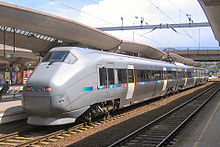 Flytoget (Airport Express Train); a High-speed rail connecting the city with its main airport, Oslo Airport, Gardermoen.
Flytoget (Airport Express Train); a High-speed rail connecting the city with its main airport, Oslo Airport, Gardermoen.
The main airport serving Oslo is Oslo Airport, Gardermoen, located in Ullensaker, 47 kilometres (29 mi) from the city centre of Oslo.[81] It acts as the main international gateway to Norway,[82] and is the sixth-largest domestic airport in Europe.[83] Gardermoen is a hub for Scandinavian Airlines, Norwegian Air Shuttle and Widerøe. Oslo is also served by two secondary airports, which serve some low-cost carriers, such as Ryanair:[84] Moss Airport, Rygge[85] and Sandefjord Airport, Torp, the latter being 110 kilometres (68 mi) from the city.[86]
Demographics
Historical populations Year Pop. ±% 1951 434,365 — 1961 475,663 +9.5% 1971 481,548 +1.2% 1981 452,023 −6.1% 1991 461,644 +2.1% 2001 508,726 +10.2% 2011 599,230 +17.8% 2021? 720,271 +20.2% 2031? 790,570 +9.8% Source: Statistics Norway.[87] An estimated 28 % of Oslo's residents are of an immigrant or non-Norwegian background (about 170,000 inhabitants),[11] predicted to increase to between 44% and 51% around 2030. In 2008, the immigrant population accounted for about 82% of the population growth of the city. From 1970 to 2007, the ethnic Norwegian population decreased by 10.1% while the immigrant population increased by 823.6%.[89] Pakistanis make up 20,812 of the city's inhabitants, followed by Somalis (10,780), Swedes (9,250), and Poles (8,854)—these being the four largest ethnic minority groups. Other large immigrant groups are people from Sri Lanka, Vietnam, Turkey, Morocco, Iraq and Denmark.[90][91][92][93]
By June 2009, more than 40% of Oslo schools had a majority of people of immigrant backgrounds, with some schools having up to a 97% immigrant share.[94] Schools are also increasingly divided by ethnicity, with white flight being widespread.[95][96] In the borough Groruddalen in 2008 for instance, the ethnic Norwegian population decreased by 1,500, while the immigrant population increased by 1,600.[97] From 2000–2007, 7,250 ethnic Norwegians moved out of the city, while 32,700 persons of immigrant background, mostly non-western, moved in.[89]
The population of Oslo is currently increasing at a record rate of nearly 2% annually (17% over the last 15 years), making it the fastest-growing Scandinavian capital.[98] The increase is due, in almost equal degree, to high birth-rates and immigration,[99] though both is largely due to immigration, seeing that the ethnic Norwegian population is actually decreasing.[89] In particular, immigration from Poland and the Baltic states has increased sharply since the accession of these countries to the EU in 2004.
Oslo is a city with various religious communities. The city has a low percentage of Christians in contrast to other parts of the country. As of 2009, 11% of the population of Oslo are Muslim, but just 3.59% are registered Muslims.[100]
Number of minorities (1st and 2nd generation) in Oslo by country of origin per 1. January 2011.[101]
Rank Ancestry Number 1  Pakistan
Pakistan21,629 2  Somalia
Somalia12,248 3  Sweden
Sweden12,088 4  Poland
Poland10,430 5  Sri Lanka
Sri Lanka7,238 6  Iraq
Iraq7,100 7  Turkey
Turkey6,130 8  Morocco
Morocco5,993 9  Vietnam
Vietnam5,694 10  Iran
Iran5,521 11  Philippines
Philippines4,642 12  India
India3,823 13  Denmark
Denmark3,377 14  Germany
Germany3,263 15  Afghanistan
Afghanistan2,741 16  Bosnia and Herzegovina
Bosnia and Herzegovina2,736 17  China, People's Republic of
China, People's Republic of2,557 18  United Kingdom
United Kingdom2,535 19  Russia
Russia2,502 20  Kosovo
Kosovo2,347 Notable residents
Main category: People from Oslo- Sigrid Undset (1882–1949), writer, awarded the Nobel Prize in Literature in 1928
- Jens Stoltenberg (b. 1959), Prime Minister
- Fabian Stang (b. 1955), mayor
- Kjetil André Aamodt (b. 1971), alpine skier
- Bruce Bawer (b. 1956), American-born literary critic, writer and poet
- Vilhelm Bjerknes (1862–1951), meteorologist
- Espen Bredesen (b. 1968), ski jumper, Olympic champion
- Anders Behring Breivik (b. 1979), right-wing terrorist
- Gro Harlem Brundtland (b. 1939), Prime Minister and Director-General of WHO
- Lars Saabye Christensen (b. 1953), author
- John Fredriksen (b. 1944), shipping magnate
- Ragnar Frisch (1895–1973), economist, Nobel Prize laureate (1969)
- Johan Galtung (b. 1930), sociologist, founder of peace and conflict studies
- Christian Krohg (1852–1925), painter
- Hans Gude[102] (1825–1903), landscape painter
- Sonja Henie (1912–1969), Norwegian figure skater and actress
- Eva Joly (b. 1943), magistrate
- Henrik Ibsen (1828–1906), playwright, theatre director and poet
- Erling Kagge (b. 1963), polar explorer
- Espen Knutsen (b. 1972), former professional ice hockey player
- Edvard Munch (1863–1944), painter
- Fridtjof Nansen (1861–1930), polar explorer, scientist, diplomat, Nobel laureate
- Lars Onsager (1903–1976), physical chemist, Nobel Prize laureate
- Børge Ousland (b. 1962), polar explorer, writer
- Grete Waitz (1953–2011), marathon runner
- Kjell Ola Dahl (b. 1958), author
- Jo Nesbø (b. 1960), author and musician
International relations
- Oslo is a pilot city of the Council of Europe and the European Commission Intercultural cities programme.[103]
Twin towns – partner cities – and regions
See also: List of twin towns and sister cities in NorwayOslo is twinned or has cooperation agreements with the following cities/regions:[104]
 Alfaz del Pi, Spain
Alfaz del Pi, Spain Gothenburg, Sweden
Gothenburg, Sweden London, United Kingdom
London, United Kingdom Gujrat, Pakistan
Gujrat, Pakistan Mazarrón, Spain
Mazarrón, Spain Mbombela, South Africa
Mbombela, South Africa St. Petersburg, Russia
St. Petersburg, Russia Schleswig-Holstein, Germany
Schleswig-Holstein, Germany Shanghai, China
Shanghai, China Vilnius, Lithuania
Vilnius, Lithuania Warsaw, Poland[105]
Warsaw, Poland[105]
Christmas trees as gifts
Oslo has a tradition of sending a Christmas tree every year to the cities of Washington, D.C., New York, London, Rotterdam, Antwerp, and Reykjavík.[104][106] Since 1947, Oslo has sent a 65–80-foot (20–25 m) high, 50 to 100 year-old spruce, as an expression of gratitude toward Britain for its support of Norway during World War II.[107][108]
See also
- East End and West End of Oslo
- List of books about Oslo
- Oslo Accords
- Parks and open spaces in Oslo
- Timeline of transport in Oslo
References
- ^ "Immigrants and Norwegian-born to immigrant parents by country of birth1,(the 20 largest groups).Selected municipalities.1 January 2011". Statistics Norway. http://www.ssb.no/innvbef_en/tab-2011-04-28-10-en.html. Retrieved 28 April 2011.
- ^ "dictionary.com". http://dictionary.reference.com/browse/oslo. Retrieved 6 August 2011.
- ^ "GaWC – The World According to GaWC 2008". Lboro.ac.uk. 13 April 2010. http://www.lboro.ac.uk/gawc/world2008t.html. Retrieved 23 July 2011.
- ^ "Worldwide Cost of Living survey: A lot of yen". The Economist (www.economist.com). 9 March 2009. http://www.economist.com/markets/rankings/displaystory.cfm?story_id=13252399.
- ^ Boyle, Catherine (20 August 2009). "So you think London’s expensive? It isn’t any more". The Times (UK: Business.timesonline.co.uk). http://business.timesonline.co.uk/tol/business/economics/article6802135.ece. Retrieved 20 August 2009.
- ^ Marowits, Ross. "The Canadian Press: Montreal beats Toronto with 12th most purchasing power in world, says UBS study". Google. http://www.google.com/hostednews/canadianpress/article/ALeqM5iMNPvwpSaHyd_tsIXBujhBQuR9eA. Retrieved 20 August 2009.[dead link]
- ^ "Sydney rockets up the list of the world’s most expensive cities". ECA International. 8 Jun 2011. http://www.eca-international.com/news/press_releases/7355/Sydney_rockets_up_the_list_of_the_world_s_most_expensive_cities. Retrieved 10 July 2011.
- ^ "Population and area, by municipality". Ssb.no. 1 April 2011. http://www.ssb.no/english/subjects/02/02/folkendrkv_en/. Retrieved 10 April 2011.
- ^ "Oslo europamester i vekst – Nyheter – Oslo". Aftenposten.no. http://www.aftenposten.no/nyheter/oslo/article4070772.ece. Retrieved 3 June 2011.
- ^ "Ola og Kari flytter fra innvandrerne – Nyheter – Oslo". Aftenposten.no. http://www.aftenposten.no/nyheter/oslo/article3424942.ece. Retrieved 3 June 2011.
- ^ a b "Immigration and immigrants". Ssb.no. 1 January 2009. http://www.ssb.no/english/subjects/00/00/10/innvandring_en/. Retrieved 29 August 2009.
- ^ "Oslo hadde 596.923 innbyggere pr. 1. oktober 2010 – Utviklings- og kompetanseetaten – Oslo kommune". Utviklings-og-kompetanseetaten.oslo.kommune.no. 19 February 2010. http://www.ssb.no/english/subjects/02/02/folkendrkv_en/2010k3/kvart02-en.html. Retrieved 28 February 2010.
- ^ "Statistics Norway". Statistics Norway. www.ssb.no. http://www.ssb.no/english/subjects/02/02/folkendrkv_en/2009k2/kvart02-en.html.
- ^ "Statistics from the SSB". Statistics Norway. www.ssb.no. http://www.ssb.no/english/subjects/02/01/10/beftett_en/tab-2009-06-16-01-en.html.
- ^ "Statistisk sentralbyrå – Forside" (in Norwegian). Statistics Norway. www.ssb.no. http://www.ssb.no/.
- ^ Jørgensen, Jon G.. "Peder Claussøn Friis". In Helle, Knut (in Norwegian). Store Norske Leksikon. Oslo: Kunnskapsforlaget. http://www.snl.no/.nbl_biografi/Peder_Clauss%C3%B8n_Friis/utdypning.
- ^ Alna – elv i Oslo, Store Norske Leksikon (in Norwegian)
- ^ Government – Oslo kommune[dead link]
- ^ Heraldry of the World (2010 [last update]). "Oslo byvåpen". ngw.nl. http://www.ngw.nl/int/nor/o/oslo.htm. Retrieved 5 July 2011.
- ^ "Inside Oslo : Inside". TripAdvisor. http://www.tripadvisor.com/Travel-g190479-s1/Oslo:Norway:Inside.html. Retrieved 25 March 2010.
- ^ Øivind Larsen. "DNMS.NO : Michael: 2005 : 03/2005 : Book review: Black Death and hard facts". Dnms.no. http://www.dnms.no/index.php?kat_id=16&art_id=87. Retrieved 3 November 2008.
- ^ Aftenposten 2011-02-25 page 11 by Cato Guhnfeldt: Som følge av rettssaker etter at barn døde/ble drept, kom det en ny fattiglov i 1900 som forbød auksjonering av barn.
- ^ Oslo temperatures
- ^ Geography of Norway#Climate
- ^ Avknut A. Nygaard. "Aftenposten: Oslofjord frozen". Aftenposten.no. http://www.aftenposten.no/nyheter/iriks/article3497775.ece. Retrieved 27 June 2010.
- ^ "Weather Information for Oslo". SSB. http://www.ssb.no/minifakta/main_02.html#tab0203. Retrieved 6 October 2008. (Norwegian)
- ^ "Climate Statistics for Oslo-Blindern, Norway (1961-1990)". November 20, 2011. http://www.theweathernetwork.com/statistics/c00090.
- ^ City of Oslo parks (Norwegian)
- ^ City of Oslo parks (Norwegian)
- ^ "Municipal swimming pools". Idrettsetaten.oslo.kommune.no. 16 June 2010. http://www.idrettsetaten.oslo.kommune.no/oslobadene/. Retrieved 27 June 2010.
- ^ Oslo Teknopol Mal
- ^ Dnv.com
- ^ "Regional accounts". Ssb.no. http://www.ssb.no/english/subjects/09/01/fnr_en/. Retrieved 10 June 2009.
- ^ "Norwegian Tax Administration Annual Report 2003" (PDF). http://www.skatteetaten.no/upload/skd%20sm03_engelsk.pdf. Retrieved 8 July 2009.
- ^ "Special Reports | Oslo 'priciest city in the world'". BBC News. 1 February 2006. http://news.bbc.co.uk/2/hi/in_depth/4669400.stm. Retrieved 21 June 2010.
- ^ "Mercer: Consulting. Outsourcing. Investments". Mercerhr.com. http://www.mercerhr.com/pressrelease/details.jhtml/dynamic/idContent/1142150. Retrieved 10 June 2009.
- ^ "In Depth | Oslo 'priciest city in the world'". BBC News. 1 February 2006. http://news.bbc.co.uk/2/hi/in_depth/4669400.stm. Retrieved 10 June 2009.
- ^ Yahoo! News[dead link]
- ^ polymorphing. "Sustainable Cities And Towns Campaign". Sustainable-cities.eu. http://sustainable-cities.eu/Sustainable-Cities-Awards-101-2-3-.html. Retrieved 21 June 2010.
- ^ Kahn, Matthew. "Living Green: Ranking the best (and worst) countries". Reader's Digest Australia. http://www.readersdigest.com.au/green-best-and-worst-countries. Retrieved 21 June 2010.
- ^ "Norges idrettshøgskole — forskning og høyere utdanning innenfor idrettsvitenskap — NIH". Nih.no. http://www.nih.no/. Retrieved 10 June 2009.
- ^ "Kunsthøgskolen i Oslo". Khio.no. 1 August 2000. http://www.khio.no/. Retrieved 10 June 2009.
- ^ "Universitetet for miljø- og biovitenskap — UMB". Umb.no. http://www.umb.no/. Retrieved 10 June 2009.
- ^ "Internett – Norges veterinærhøgskole". Veths.no. http://www.veths.no/. Retrieved 10 June 2009.
- ^ Ska-Wiki – Ska-Wiki
- ^ "A crowded field". The Economist. 27 May 2010. http://www.economist.com/node/16219707?story_id=16219707.
- ^ "Edvard Munch» Edvard Munch Biography 3". Edvardmunch.info. http://www.edvardmunch.info/biography-3/. Retrieved 3 June 2011.
- ^ a b http://www.haveiendom.no/filestore/uppdateringar__og__mars/MUNCH.pdf
- ^ Tone:. "Attractions: Museums and sights of Oslo, Norway". Visitoslo.com. http://www.visitoslo.com/en/attractions-and-sights.49105.en.html. Retrieved 3 June 2011.
- ^ "Oslo Museums | Oslo Museums". World66.com. 18 March 2005. http://www.world66.com/europe/norway/oslo/museums. Retrieved 3 June 2011.
- ^ "Frognerparken and Vigeland Park – Oslo". Cosmotourist. http://www.cosmotourist.com/travel/d/i/2424901/t/oslo/frognerparken-and-vigeland-park/. Retrieved 3 June 2011.
- ^ "Sinnataggen". Oslosurf.com. http://www.oslosurf.com/innhold/00000038.shtml. Retrieved 3 June 2011.
- ^ Norway dot com. "The Viking Ship Museum (Vikingskipshuset), Museums, Oslo Norway Directory". Norway.com. http://www.norway.com/directories/d_company.asp?id=671. Retrieved 3 June 2011.
- ^ Norway dot com. "Oslo City Museum, Museums, Oslo Norway Directory". Norway.com. http://www.norway.com/directories/d_company.asp?id=1742. Retrieved 3 June 2011.
- ^ "The Kon-Tiki Museum – Norway official travel guide". visitnorway.com. http://www.visitnorway.com/en/Product/?pid=28951. Retrieved 3 June 2011.
- ^ a b c "About the National Museum : Nasjonalmuseet". Nasjonalmuseet.no. http://www.nasjonalmuseet.no/en/about_the_national_museum/about_the_national_museum/. Retrieved 3 June 2011.
- ^ "The National Museum at Vestbanen : Nasjonalmuseet". Nasjonalmuseet.no. http://www.nasjonalmuseet.no/en/about_the_national_museum/the_national_museum_at_vestbanen/. Retrieved 3 June 2011.
- ^ a b "Nobel Peace Center Opens in Oslo". Norway.org. http://www.norway.org/ARCHIVE/policy/peace/peacecenter/. Retrieved 3 June 2011.
- ^ OJF (2011 [last update]). "Oslo Jazzfestival". oslojazz.no. http://www.oslojazz.no/indexENG.php. Retrieved 5 July 2011.
- ^ Øya (2011 [last update]). "Øyafestivalen – News". oyafestivalen.com. http://www.oyafestivalen.com/pages/eng/1-news. Retrieved 5 July 2011.
- ^ NobelPrize.Org (2011 [last update]). "The Nobel Peace Prize Award Ceremony 2010". nobelprize.org. http://nobelprize.org/nobel_prizes/peace/laureates/2010/award-video.html. Retrieved 5 July 2011.
- ^ VisitOslo.Com (2011 [last update]). "World Cup Biathlon - Official Travel & Visitor's Guide to Oslo, Norway". visitoslo.com. http://www.visitoslo.com/en/world-cup-biathlon.77706.242653rd17.tlp.html. Retrieved 5 July 2011.
- ^ Desu.No (2011 [last update]). "Desu" (in Norwegian). desu.no. http://www.desu.no/. Retrieved 5 July 2011.
- ^ KNS.No (2011 [last update]). "Fokus Bank Færderseilasen – KNS". kns.no. http://kns.no/nor/Regatta/Regattasider/Fokus_Bank_Farderseilasen/. Retrieved 5 July 2011.
- ^ Oslo-Filharmonien (2011 [last update]). "Filharmonien". oslofilharmonien.no. http://www.oslofilharmonien.no/lang/en/. Retrieved 5 July 2011.
- ^ a b "Nationaltheatret – National Theatre: Photos and videos on Google Maps, the WIKI-way". 59.914386,10.7342595: Wiki.worldflicks.org. http://wiki.worldflicks.org/nationaltheatret_-_national_theatre.html. Retrieved 3 June 2011.
- ^ "7 of the Best Tourist Attractions in Oslo, Norway". Globe Tales. http://www.globetales.com/7-of-the-best-tourist-attractions-in-oslo-norway. Retrieved 3 June 2011.
- ^ Økland, Ingunn (10 September 2008). "Ibsen som jålete graffiti" (in Norwegian). Aftenposten. http://www.aftenposten.no/meninger/debatt/article2645410.ece.
- ^ Ullevaal Stadion. "Historikk" (in Norwegian). http://www.ullevaal-stadion.no/index.asp?id=26090. Retrieved 10 June 2009.
- ^ "7 Dead in Oslo Explosion; 80 Killed in Shooting at Camp". PBS. http://www.pbs.org/newshour/rundown/2011/07/2-explosions-at-norway-government-building-pm-unharmed.html. Retrieved 23 July 2011.
- ^ "Om Ruter" (in Norwegian). Ruter. http://www.ruter.no/Om-Ruter-As/. Retrieved 1 December 2010.
- ^ "T-banen – forstadsbane og storbymetro" (in Norwegian). Ruter. http://www.ruter.no/Rutetilbud/T-bane/. Retrieved 1 December 2010.
- ^ "Trikk" (in Norwegian). Ruter. http://www.ruter.no/Rutetilbud/Trikk/. Retrieved 1 December 2010.
- ^ "Network map commuter trains" (in Norwegian). Norwegian State Railways. http://www.nsb.no/getfile.php/www.nsb.no/nsb.no/Bilder/Rutetabeller/Lokaltogkart%20A4.pdf. Retrieved 1 December 2010.
- ^ "T-baneringen" (in Norwegian). Oslo Package 2. http://www.avinet.no/Oslopakke2/database/faktaark_ny.aspx?id=46. Retrieved 1 December 2010.
- ^ "Oslo S bygges om for 2.9 milliarder kroner" (in Norwegian). Rom Eiendom. http://www.romeiendom.no/getfile.php/wimages/Organisasjoner%20og%20enheter/ROM/Pressemelding%20OSLO%20S.doc. Retrieved 19 December 2009.[dead link]
- ^ "Network map" (in Norwegian). Norwegian State Railways. http://www.nsb.no/getfile.php/www.nsb.no/nsb.no/Bilder/Rutetabeller/NSB%20Map.pdf. Retrieved 1 December 2010.
- ^ Holøs, Bjørn (1990) (in Norwegian). Stasjoner i sentrum. Oslo: Gyldendal Norsk Forlagg. p. 182. ISBN 82-05-19082-8.
- ^ "Båt til jobb og skole, eller bad og utflukt" (in Norwegian). Ruter. http://www.ruter.no/Rutetilbud/Bat/. Retrieved 1 December 2010.
- ^ "Passasjer/turist" (in Norwegian). Port of Oslo. http://www.oslohavn.no/passasjerer/. Retrieved 1 December 2010.
- ^ "Administration". Oslo Lufthavn. http://www.osl.no/en/osl/aboutus/80_Airport+administration. Retrieved 19 January 2010.
- ^ "Market". Oslo Lufthavn. http://www.osl.no/en/osl/businesstobusiness/_airlines/10_Market. Retrieved 19 January 2010.
- ^ "Economic crisis stops air transport growth". Eurostat. http://epp.eurostat.ec.europa.eu/cache/ITY_OFFPUB/KS-SF-09-091/EN/KS-SF-09-091-EN.PDF. Retrieved 18 January 2010.
- ^ "Rygge-London for én krone" (in Norwegian). Akershus Amtstidende. 17 July 2009.
- ^ "Information about Moss Airport Rygge". Rygge Sivile Lufthavn. http://www.en.ryg.no/kat/000005.asp. Retrieved 25 November 2010.[dead link]
- ^ Sandefjord Lufthavn. "How do I get to Sandefjord Airport Torp?". http://www.torp.no/Pages/Artikkel.aspx?pkMenu=131&pksMenu=143&Language=EN. Retrieved 24 October 2009.
- ^ "Projected population – Statistics Norway". Statbank.ssb.no. http://statbank.ssb.no/statistikkbanken/Default_FR.asp?PXSid=0&nvl=true&PLanguage=0&tilside=selecttable/hovedtabellHjem.asp&KortnavnWeb=folkfram. Retrieved 23 July 2011.
- ^ Statistics Norway – Church of Norway.
- ^ a b c Gifford, Erik. "Innvandring gir befolkningseksplosjon i Oslo". document.no. http://www.document.no/2009/07/tabell_1_oversikt_over_befolkn.html. Retrieved 30 April 2010.
- ^ (Norwegian) 25 prosent av alle som bor i Oslo er innvandrere – Nyheter – Oslo – Aftenposten.no
- ^ "Polakker den største innvandrergruppen" (in (Norwegian)). Ssb.no. http://www.ssb.no/emner/02/01/10/innvbef. Retrieved 27 June 2010.
- ^ "Tabell 11 Innvandrere og norskfødte med innvandrerforeldre, etter landbakgrunn (de 20 største gruppene). Utvalgte kommuner. 1. januar 2009" (in (Norwegian)). Ssb.no. http://www.ssb.no/emner/02/01/10/innvbef/arkiv/tab-2009-04-30-11.html. Retrieved 22 January 2010.[dead link]
- ^ Folkebibl.no (Norwegian)
- ^ Avhilde Lundgaard . "Foreldre flytter barna til "hvitere" skoler – Nyheter – Innenriks". Aftenposten.no. http://www.aftenposten.no/nyheter/iriks/article3228559.ece. Retrieved 25 March 2010.
- ^ Bredeveien, Jo Moen (2 June 2009). "Rømmer til hvitere skoler". Dagsavisen. http://www.dagsavisen.no/innenriks/article418561.ece.
- ^ Lundgaard, Hilde (22 August 2009). "Foreldre flytter barna til "hvitere" skoler". Aftenposten. http://www.aftenposten.no/nyheter/iriks/article3228559.ece.
- ^ Slettholm, Andreas (15 December 2009). "Ola og Kari flytter fra innvandrerne". Aftenposten. http://www.aftenposten.no/nyheter/oslo/article3424942.ece.
- ^ Ole Kristian Nordengen Hanne Waaler Lier Pål V. Hagesæther. "Om 15 år kan det bo 100 000 flere i Oslo". Aftenposten.no. http://www.aftenposten.no/nyheter/oslo/article1139976.ece. Retrieved 27 June 2010.
- ^ "Table 03 03 Oslo. Population 1 January and population changes during the year. 1951". Ssb.no. http://www.ssb.no/english/subjects/02/02/folkendrhist_en/tables/tab/03.html. Retrieved 10 June 2009.
- ^ "Mellom 4 og 11 prosent muslimer i 2060 – nyheter". Dagbladet.no. 15 April 2009. http://www.dagbladet.no/2009/04/15/nyheter/innvandring/innenriks/politikk/islam/5756098/. Retrieved 30 April 2010.
- ^ "Immigrants and Norwegian-born to immigrant parents, by country of birth1, (the 20 largest groups). Selected municipalities. 1 January 2011" (in (Norwegian)). ssb.no. http://www.ssb.no/innvbef_en/tab-2011-04-28-10-en.html. Retrieved 2 August 2011.
- ^ Haverkamp, Frode; Gude, Hans Fredrik (1992) (in Norwegian). Hans Gude. Oslo: Aschehoug. p. 59. ISBN 8203170722. OCLC 29047091.
- ^ Council of Europe (2011 [last update]). "Intercultural city: Oslo, Norway". coe.int. http://www.coe.int/t/dg4/cultureheritage/culture/Cities/oslo_en.asp. Retrieved 22 May 2011.
- ^ a b "Partners – Oslo kommune". Oslo.kommune.no. http://www.oslo.kommune.no/the_city_of_oslo/international_cooperation/. Retrieved 27 June 2010.[dead link]
- ^ "Miasta partnerskie Warszawy". um.warszawa.pl. Biuro Promocji Miasta. 4 May 2005. http://um.warszawa.pl/v_syrenka/new/index.php?dzial=aktualnosci&ak_id=3284&kat=11. Retrieved 29 August 2008.[dead link]
- ^ Aftenposten Newspaper: Oslo tree is London-bound (English)
- ^ "Christmas in Trafalgar Square: "Recycling the tree" and "About the tree" ''(Greater London Authority website)''". London.gov.uk. http://www.london.gov.uk/trafalgarsquare/events/xmas.jsp. Retrieved 27 June 2010.
- ^ Christmas tree recycling (City of Westminster Council website).[dead link]
External links
- Oslo Virtual Tour – 360* panoramic pictures
- Oslo travel guide from Wikitravel
- City of Oslo: Official website (Norwegian)
- City of Oslo: Official website (English)
- Official Travel and Visitors Guide to Oslo
- Oslo The official travel guide to Norway
- Oslo - Local Travel Information Guide Oslo city
- SNL.no Online encyclopedia Store Norske Leksikon's entry about Oslo
Categories:- Host cities of the Winter Olympic Games
- Oslo
- 1040s establishments in Norway
- Populated places established in the 11th century
- Capitals in Europe
- Cities and towns in Norway
- Counties of Norway
- Populated coastal places in Norway
- Port cities and towns in Norway
- Port cities and towns of the North Sea
- Viking Age populated places
Wikimedia Foundation. 2010.



